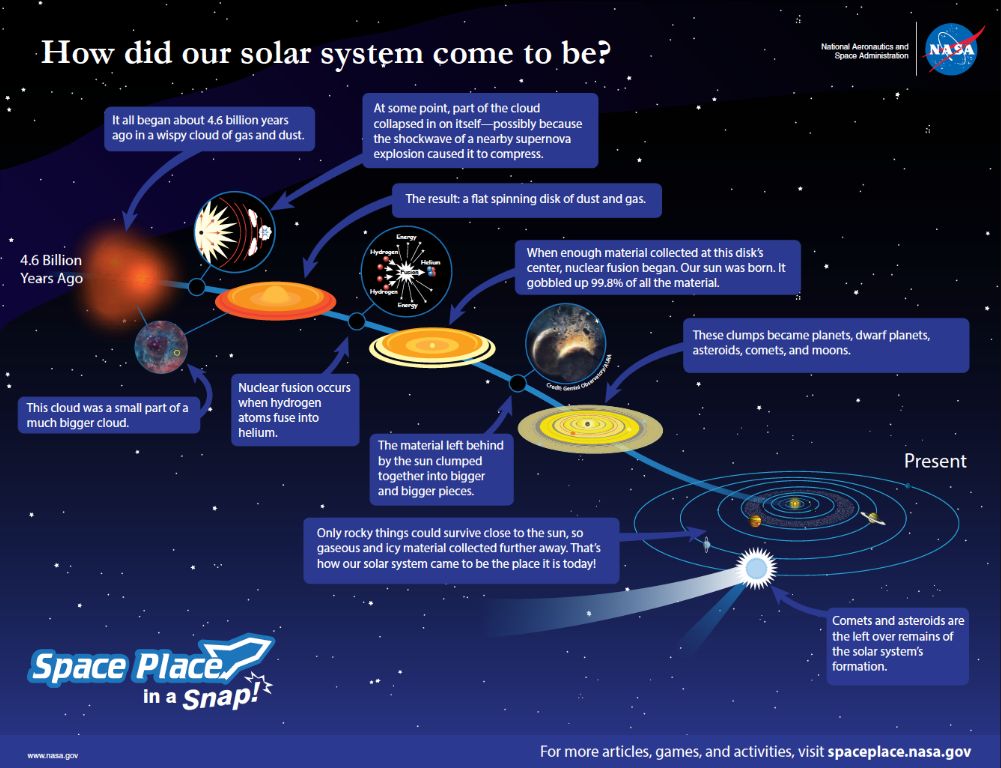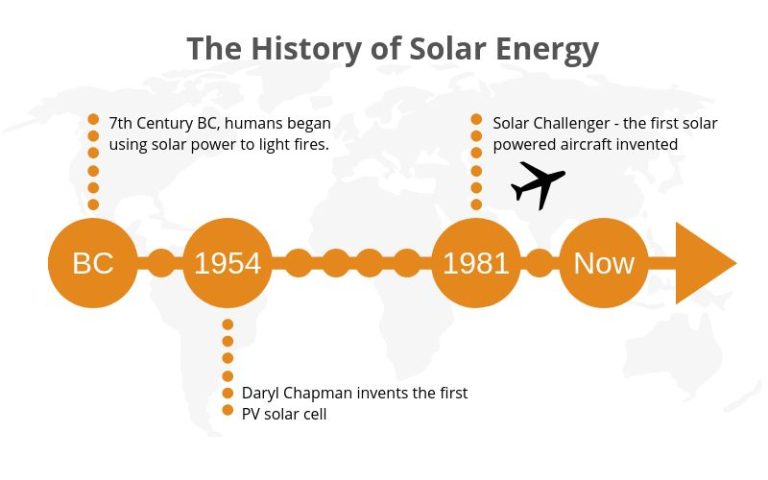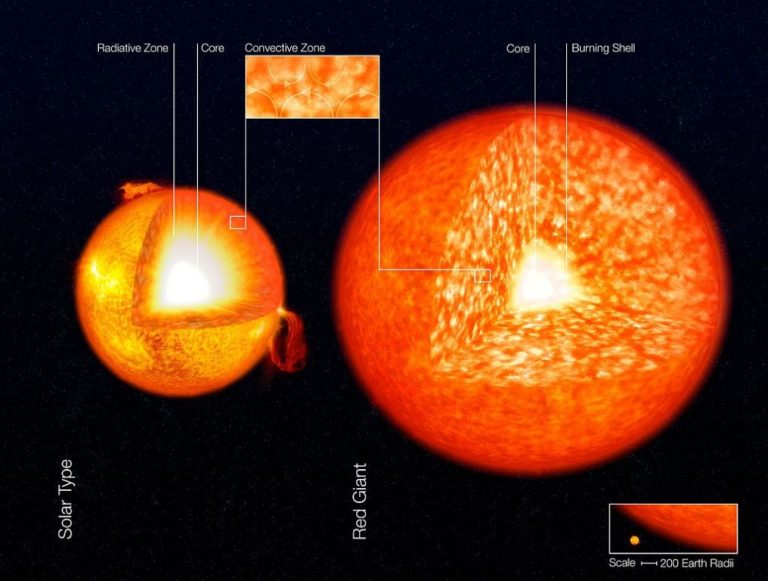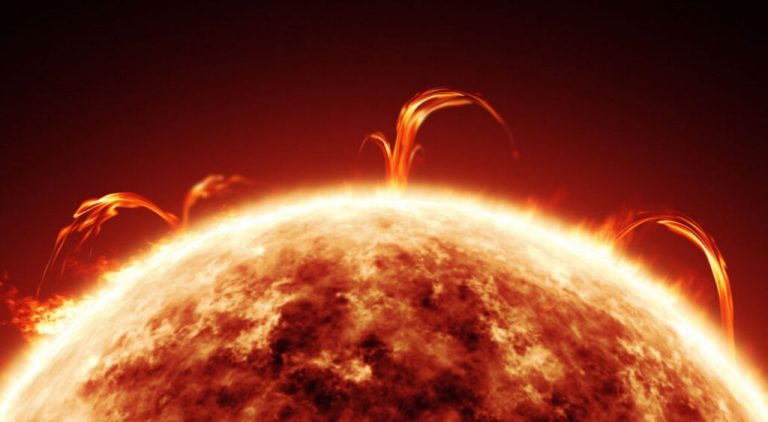Was Our Solar System Born?

The question of whether our solar system was “born” is a fascinating topic that has intrigued astronomers and scientists for centuries. It explores the origins of the Sun, planets, moons, and other objects in our cosmic neighborhood. Examining how and when our solar system formed provides clues about the early conditions of the solar system and can help explain properties of planets. This brief overview will look at some early theories about solar system formation as well as more modern ideas. It will also touch on topics like planet formation, the origins of the Sun and Earth, and the asteroid belt. Understanding the “birth” of our solar system gives us perspective on our place in the universe and insight into planetary systems around other stars.
Early Theories
Early ideas about solar system formation were based on the nebular hypothesis first proposed by philosopher Immanuel Kant and mathematician Pierre-Simon Laplace in the 18th century (Planet Formation: Theory, Observations, and Experiments). According to this hypothesis, the Sun originally formed from a large rotating cloud of gas and dust. As the cloud contracted under gravity, it spun faster and flattened into a disk. The planets then condensed from matter in the disk orbiting around the proto-Sun. The Laplace hypothesis provided an early framework for understanding the initial formation of the solar system, though modern theories have built upon it with more detailed models and evidence from astronomical observations.
Modern Theories
The modern nebular theory, also known as the solar nebular disk model, is the leading theory for how our solar system formed. This theory states that the solar system originated from a large rotating cloud of gas and dust known as a solar nebula. As this nebula collapsed under its own gravity, conservation of angular momentum caused it to spin faster and flatten into a disk. Most of the material was pulled into the center to form the Sun, while the rest of the disk cooled and separated into rings and clumps of matter. From these accumulating clumps of dust and gas, the planets began to form around 4.6 billion years ago.
There is strong evidence supporting the nebular theory from observations of protoplanetary disks. Protoplanetary disks are rotating disks of dense gas and dust that surround newly formed stars. These disks are thought to be the sites of active planet formation. Images from powerful telescopes like the Atacama Large Millimeter Array (ALMA) have provided detailed views of these protoplanetary disks with rings and gaps, similar to how our solar system is structured. The existence of these disks supports the idea that our own solar system originated from a nebular disk.
Overall, the nebular theory provides the best explanation for the structure and motions we observe in our solar system today. It accounts for details like the planets orbiting the Sun in the same plane and direction, the angular momentum of the planets, and the composition gradients across the solar system. While a few details are still being investigated, the nebular theory gives a strong framework for understanding our cosmic origins.
Planet Formation
Planets are believed to form through the process of accretion, where small particles collide and stick together over time to form ever larger bodies called planetesimals. Eventually, the largest planetesimals attract more material through gravity and clear their orbital path to become protoplanets.
Terrestrial planets like Earth form in the inner solar system where temperatures are too hot for gases like hydrogen and helium to condense. These planets are made of rock and metals. Gas giants like Jupiter form further out where ices like water, methane, and ammonia can condense to form solid cores. Once these cores reach 5-10 times the mass of Earth, they have enough gravity to rapidly accrete gas from the protoplanetary disk. This is why gas giants like Jupiter and Saturn consist mostly of lighter elements like hydrogen and helium.
According to the book “Earth: Evolution of a Habitable World”, the process of planetary accretion explains why the oldest whole rock samples on Earth date back to the same time that the planets formed. As particles collided and stuck, the kinetic energy was converted to heat which melted and differentiated the growing planets into layers like cores, mantles, and crusts (https://books.google.com/books?id=sZgB52BCa0UC&pg=PA69&lpg=PA69&dq=%22planet+formation+accretion+process%22&source=bl&ots=Brp1RWNwIG&sig=ACfU3U3Q7dY8SlJ-w0VpKmZRnD_YmeXnIw&hl=en&sa=X&ved=2ahUKEwis5Z-3ldyDAxVASPEDHUp_BEUQ6AF6BAgJEAM).
Challenges
While scientists have made significant progress in understanding how our solar system formed, there are still many unanswered questions and challenges. Some of the main challenges include:
Accounting for the distribution of mass – While the Sun contains 99.8% of the solar system’s mass, the remaining 0.2% is distributed in an uneven way among the planets. Explaining this uneven distribution has proven difficult.
Understanding planetary migration – Evidence suggests that the outer planets may have formed closer to the Sun initially before migrating outwards to their current positions. Models have struggled to fully explain this migration process.
Explaining the Late Heavy Bombardment – There is evidence of a spike in the impact rate of asteroids and comets between 4 to 3.8 billion years ago. Theories differ on what caused this and how it affected planet formation.
Determining the initial composition and conditions – Detailed knowledge of the early solar system’s initial composition and conditions is lacking but key for testing formation models. Reconstructing these initial conditions remains challenging.
While theories continue to improve, overcoming these and other challenges will be key to developing a complete picture of how our solar system was born. The answers may come from new models, space missions, or studying exoplanetary systems.
Origin of the Sun
The leading theory on the formation of the Sun is known as the Nebular Hypothesis, first proposed in 1734 by Emanuel Swedenborg and later expanded upon by Immanuel Kant and Pierre-Simon Laplace in 1796. According to the Nebular Hypothesis, the solar system formed from a large, rotating cloud of interstellar dust and gas called a solar nebula. As this nebula contracted under its own gravity, rotation accelerated and the nebula flattened into a spinning protoplanetary disk with a protostar at the center. Material within this spinning disk collided and aggregated through accretion to create ever larger clumps and eventually the planets, moons, asteroids and other objects.
Evidence supporting the Nebular Hypothesis includes observations of disks and rotating knots of gas and dust around very young stars, indicating early stages of planetary system formation. The presence of rocky planets close to the Sun and gas giants farther away also matches predictions of the theory. Additionally, the orbits of the planets are aligned in the same orbital plane and direction of rotation, suggesting a shared origin. While some details are still being refined, the Nebular Hypothesis remains the predominant explanation for the formation of our Solar System.
The protostar at the center of the nebula contracted and heated up to form the Sun we see today. Conservation of angular momentum as the nebula collapsed led to increased rotation and formation of an accretion disk that enabled gathering of more material and growth of the protostar. Once temperatures reached approximately 10 million K, fusion of hydrogen into helium began and ignited the steady brilliance of our star. The Sun accumulated over 99% of the available matter from the nebula, leaving less than 1% to produce the planets, moons, asteroids and comets.
For more details on theories and evidence on the origins of the Sun specifically, see:
Oldest Material in Solar System Found
Origin of Earth
According to modern scientific theories, the Earth formed over 4.5 billion years ago from a cloud of dust and gas that surrounded the young Sun. As this nebula collapsed under gravity, particles collided and stuck together, growing into small chunks called planetesimals. Over millions of years, the planetesimals combined into protoplanets, and eventually into planets.
There is strong geological evidence that supports this view of Earth’s formation. Analysis of meteorites suggests that >material in the solar system dates back 4.56 billion years. Zircon crystals found in Australia are 4.4 billion years old, making them the oldest fragments of Earth’s crust. The ratios of different isotopes of elements like oxygen, titanium, tungsten and others match what would be expected from planetary accretion.
According to the standard model, once Earth grew large enough through accretion, its gravity pulled in surrounding gases to form an atmosphere and molten iron sank to the center to form a core. Heavier elements like iron and nickel migrated inward, while lighter silicate rocks rose to the surface. The early Earth experienced many huge collisions with other planetesimals and protoplanets, including a Mars-sized object that likely created the Moon [1]. These impacts released heat that melted Earth’s exterior into magma oceans.
While uncertainties remain, this general model of planetary accretion from a solar nebula is supported by a wide range of evidence. The process took tens of millions of years, but gravity eventually pulled together the dust, rocks, and gases to form the Earth we know today.
Origin of Moons
The most widely accepted theory for how moons like our own Moon formed is called the giant impact hypothesis or giant impact theory. According to this theory, moons are formed from the debris left over after a collision between a planet and another large celestial body.
In the case of our Moon, the theory states that early in Earth’s history, over 4.5 billion years ago, Earth was struck by a Mars-sized planet called Theia. This collision threw a huge amount of debris into space around Earth. Over time, through accretion, this debris accumulated and coalesced into our Moon.
Evidence supporting the giant impact theory includes the fact that Earth’s spin and the Moon’s orbit have identical orientation, suggesting a common origin. Additionally, analysis of lunar samples brought back by the Apollo missions showed that the Moon’s composition is very similar to that of Earth’s mantle and crust. This further points to a shared origin (Source 1).
While the giant impact theory is widely accepted, some variations have been proposed. For example, one idea suggests that instead of one giant impact, multiple smaller impacts could have contributed debris that accumulated into the Moon (Source 2). Regardless of the details, most experts agree that a major collision between Earth and a large body led to the formation of our Moon.
Origin of Asteroid Belt
The asteroid belt is a region of space between the orbits of Mars and Jupiter that contains millions of asteroids. There are several theories for how the asteroid belt formed:
One early theory was that a planet once formed in the asteroid belt but was destroyed in a catastrophic collision. This theory was proposed in the 19th century, but has fallen out of favor as astronomers have learned more about planet formation. According to this source, one version of this theory proposed that a planet-sized body formed between Mars and Jupiter and was somehow destroyed, leaving only the asteroids behind.
The more widely accepted view today is that the asteroids are planetesimals, the building blocks of planets that never quite came together to form a planet. As explained in this source, the gravity of Jupiter disrupted the material in the asteroid belt region, preventing the asteroids from accreting into a planet. The asteroids we see today are the leftovers from that process.
So in summary, the asteroid belt likely represents primordial material from the early solar system that was prevented from forming a planet due to the strong gravitational influence of nearby Jupiter.
Conclusion
In conclusion, we have explored several theories about the origins of our solar system. The most widely accepted modern theory is that the solar system formed about 4.6 billion years ago from a giant cloud of dust and gas known as a solar nebula. As this cloud collapsed under its own gravity, the Sun formed at the center, while surrounding dust and gas disks gradually coalesced into the planets, moons, asteroids and other objects. Key steps included the accretion of small particles into larger bodies like asteroids and planetesimals, and the clearing of gas and dust between the newly forming planets. Challenges remain in understanding the details, such as why the planets ended up in their current configuration. However, astronomers continue to find new evidence and refine models to deepen our knowledge. By reviewing the journey from early ideas to modern cosmological models, we have gained insight into the forces and conditions that gave rise to our amazing solar system so long ago.







